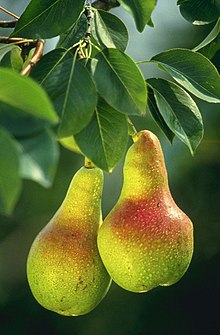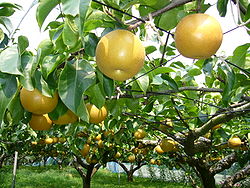梨: difference between revisions
m move 4= to t= in {{desc}}; remove extraneous 3= in {{desc}} |
|||
| Line 58: | Line 58: | ||
===Descendants=== |
===Descendants=== |
||
* {{desc|hmx-pro|*rəj| |
* {{desc|hmx-pro|*rəj|t=pear|bor=1}} |
||
{{zh-cat|Fruits|Elementary}} |
{{zh-cat|Fruits|Elementary}} |
||
Revision as of 22:49, 26 June 2022
| ||||||||
| ||||||||
Translingual
Han character
梨 (Kangxi radical 75, 木+7, 11 strokes, cangjie input 竹弓木 (HND) or 難竹弓木 (XHND), four-corner 22904, composition ⿱利木)
References
- Kangxi Dictionary: page 530, character 12
- Dai Kanwa Jiten: character 14873
- Dae Jaweon: page 918, character 10
- Hanyu Da Zidian (first edition): volume 2, page 1215, character 10
- Unihan data for U+68A8
Chinese
| trad. | 梨 | |
|---|---|---|
| simp. # | 梨 | |
| alternative forms | 棃 梸 | |
Glyph origin
| Historical forms of the character 梨 | |
|---|---|
| Shuowen Jiezi (compiled in Han) | Liushutong (compiled in Ming) |
| Small seal script | Transcribed ancient scripts |

|

|
Phono-semantic compound (形聲/形声, OC *ril) : phonetic 利 (OC *rids) + semantic 木.
Etymology
Unknown. Also found in Proto-Hmong-Mien *rəj; folk etymology derives this from 利 (OC *rids, “sharp”) (Schuessler, 2007).
Pronunciation
Lua error in Module:wuu-pron at line 157: Incorrect tone notation "3" for sh. See WT:AZH/Wu.
Definitions

- pear (Classifier: 個/个 m c; 隻/只 c)
- † (deprecated template usage) Alternative form of 剺 (lí, “to cut”).
Synonyms
Compounds
Lua error in Module:zh/templates at line 32: This template has been deprecated. Please use Template:col3 instead.
Descendants
- → Proto-Hmong-Mien: *rəj (“pear”)
Japanese
Kanji
Readings
Etymology 1
| Kanji in this term |
|---|
| 梨 |
| なし Grade: 4 |
| kun'yomi |
From Old Japanese [Term?]. Derivation unclear, with numerous theories. Two of the more common are given below.
- May be originally a compound of 中 (na, “middle, center”, hypothesized root of modern naka) + 白 (shiro, “white”) in reference to the pale flesh of the fruit.
- */na ɕiro/ → /naɕi/
- Alternatively, may be originally a compound of 中 (na, “middle, center”, hypothesized root of modern naka) + 酢 (su, “sour, acidic”) in reference to the way the flavor of the fruit becomes more astringent closer to the core.
- */na su/ → /naɕi/
Pronunciation
Lua error in Module:ja-pron at line 88: Parameter "yomi" is not used by this template.
Alternative forms
Noun
- a pear tree
- a pear (the fruit)
- more specifically, the Japanese pear(Please check if this is already defined at target. Replace
{{vern}}with a regular link if already defined. Add novern=1 if not defined.) or Asian pear, Pyrus pyrifolia
Derived terms
- 梨河豚 (nashifugu): the pear puffer: Lua error in Module:taxlink at line 68: Parameter "ver" is not used by this template., syn. Lua error in Module:taxlink at line 68: Parameter "ver" is not used by this template.
- 梨子地 (nashiji), 梨地 (nashiji): nashiji, a lacquering technique using gold or silver powder or flakes
- 青梨 (ao nashi): a Harbin pear, Ussurian pear, Chinese pear(Please check if this is already defined at target. Replace
{{vern}}with a regular link if already defined. Add novern=1 if not defined.): Lua error in Module:taxlink at line 68: Parameter "ver" is not used by this template. - 玄圃梨 (kenpo nashi): the Japanese raisin tree: Lua error in Module:taxlink at line 68: Parameter "ver" is not used by this template.
- 猿梨 (saru nashi): the hardy kiwi, kiwi berry or tara vine: Lua error in Module:taxlink at line 68: Parameter "ver" is not used by this template.
- 西洋梨 (seiyō nashi): the European or Western pear: Pyrus communis
- 浜梨 (hama nashi): the rugosa rose, Japanese rose(Please check if this is already defined at target. Replace
{{vern}}with a regular link if already defined. Add novern=1 if not defined.), or Ramanas rose: Lua error in Module:taxlink at line 68: Parameter "ver" is not used by this template. - 山梨 (yama nashi): the wild nashi or wild Japanese pear: Lua error in Module:taxlink at line 68: Parameter "ver" is not used by this template.
- 山梨県 (Yamanashi-ken): Yamanashi prefecture
- 洋梨 (yōnashi): the European or Western pear: Pyrus communis
- 鰐梨 (wani nashi): the avocado or alligator pear: Persea americana
Usage notes
As with many terms that name organisms, this term is often spelled in katakana, especially in biological contexts (where katakana is customary), as ナシ.
Etymology 2
| Kanji in this term |
|---|
| 梨 |
| り Grade: 4 |
| on'yomi |
From Middle Chinese 梨 (*li). Compare modern Mandarin reading lí.
Pronunciation
Lua error in Module:ja-pron at line 88: Parameter "yomi" is not used by this template.
Affix
- a pear tree
- a pear (the fruit)
- more specifically, the Japanese pear(Please check if this is already defined at target. Replace
{{vern}}with a regular link if already defined. Add novern=1 if not defined.) or Asian pear, Pyrus pyrifolia
Derived terms
Etymology 3
| Kanji in this term |
|---|
| 梨 |
| りん Grade: 4 |
| kan'yōon |
Alteration of ri reading.
/ri/ → /rin/
Pronunciation
Lua error in Module:ja-pron at line 88: Parameter "yomi" is not used by this template.
Affix
Derived terms
- 花梨 (karin) the Burmese rosewood, angsana, amboyna: Pterocarpus indicus; the flowering quince: Pseudocydonia sinensis; the Chinese quince: Lua error in Module:taxlink at line 68: Parameter "ver" is not used by this template.; the quince: Cydonia oblonga
References
Korean
Hanja
梨 (eumhun 배나무 리 (baenamu ri), word-initial (South Korea) 배나무 이 (baenamu i))
Vietnamese
Han character
- CJK Unified Ideographs block
- Han script characters
- CJK Compatibility Ideographs block
- Translingual lemmas
- Translingual symbols
- Han phono-semantic compounds
- Chinese lemmas
- Chinese Han characters
- Chinese nouns classified by 個/个
- Chinese nouns classified by 隻/只
- Chinese terms with obsolete senses
- zh:Fruits
- Elementary Mandarin
- Japanese Han characters
- Japanese fourth grade kanji
- Japanese kyōiku kanji
- Japanese jōyō kanji
- Japanese kanji with goon reading り
- Japanese kanji with kan'on reading り
- Japanese kanji with kan'yōon reading りん
- Japanese kanji with kun reading なし
- Japanese kanji with nanori reading か
- Japanese terms spelled with 梨 read as なし
- Japanese terms read with kun'yomi
- Japanese terms inherited from Old Japanese
- Japanese terms derived from Old Japanese
- Japanese compound terms
- Japanese lemmas
- Japanese nouns
- Japanese terms with multiple readings
- Japanese terms spelled with fourth grade kanji
- Japanese terms written with one Han script character
- Japanese terms spelled with 梨
- Japanese single-kanji terms
- Japanese terms spelled with 梨 read as り
- Japanese terms read with on'yomi
- Japanese terms derived from Middle Chinese
- Japanese affixes
- Japanese terms spelled with 梨 read as りん
- Japanese terms read with kan'yōon
- ja:Fruits
- Korean lemmas
- Korean Han characters
- Vietnamese lemmas
- Vietnamese Han characters
- Vietnamese Chữ Hán

